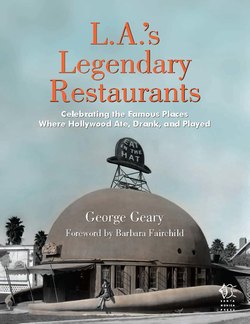Читать книгу L.A.'s Legendary Restaurants - George Geary - Страница 10
ОглавлениеOPEN: 1906–1996
LOCATION: 7007 Hollywood Boulevard Hollywood, CA 90028
ORIGINAL PHONE: HO 4-9755
CUISINE: Dessert
DESIGN: Meyer & Holler
BUILDING STYLE: Renaissance
CURRENTLY: Clothing Store
FROM 1906 TO 1918, CLARENCE CLIFTON BROWN WORKED ALONE, MAKING HIS RAGTIME CHOCOLATES AT 715 S. FLOWER STREET IN DOWNTOWN LOS ANGELES (NOW MACY’S PLAZA) WITH A LARGE COPPER KETTLE THAT HE HAD BROUGHT WITH HIM FROM OHIO. C. C. Jr. joined his dad in the business in 1918 and began experimenting with the chocolate mixtures, trying to create a sauce that would not harden when exposed to air the way typical candy coatings did.
In 1929, the duo moved their business to 7007 Hollywood Boulevard, next to the newly opened Grauman’s Chinese Theatre and across the street from the El Capitan Theatre and the Hollywood Roosevelt Hotel. It took nearly ten more years before the Browns thought their C. C. Brown’s Hot Fudge Sauce had reached perfection, finally debuting the concoction in 1938.
To cash in on the Olympic fever of 1932, Clarence opened a C. C. Brown’s Candy Store at 3834 Wilshire Boulevard, about two blocks from Western Avenue. It only stayed open for one year. The C. C. Brown’s on Hollywood Boulevard, however, became a popular hangout for locals, tourists, and celebrities alike. The shop always had an intense, captivating aroma of chocolate and caramel. Its chocolate-colored booths were thoughtfully elevated to create a sense of private space, a subtle filter so tourists could glimpse—but not intrude upon—the celebrities seated nearby.
Without a doubt, the place had a star-studded following. A teenaged Judy Garland was a server there. Marilyn Monroe called it her favorite date spot. Marlon Brando savored his ice cream in his limo parked out front while his family ate inside, so he wouldn’t be bothered. Clark Gable, Mary Pickford, Joan Crawford, Art Linkletter, Bob Hope, and Elvis Presley were regulars. One frequent customer would eventually become president of the United States: Ronald Reagan. (After Hinckley attempted to assassinate President Reagan, C. C. Brown’s shipped a case of their famous hot fudge sauce to the White House as a tribute. Mr. Reagan’s gracious thank-you note was displayed in a case by the cash register.)
The servers wore pristine white uniforms, and the ice cream menu was extensive. The most popular choices were the Hot Fudge Sundae, the Caramel Sundae, the Buster Brown, and the Brownie—the boss’s eponymous sundae. The Brownie didn’t actually contain brownies, but it did have a sliced banana, scoops of vanilla and chocolate ice cream, marshmallow and milk chocolate sauces, fresh whipped cream, and a sprinkle of chopped roasted almonds. The Hot Fudge Sundae was served in a silver goblet; C. C. claimed that the metal kept the ice cream cold longer. The all-important two-and-a-half ounces of hot fudge sauce were served on the side, in a brown ceramic pitcher. The original hot fudge sauce that Brown and his son had worked so hard to perfect stayed creamy on top of the ice cream without hardening or sliding off.
In 1959, John Schumacher, a close friend of the Browns and a dairy chemist with the Carnation Ice Cream Company, started working at C. C. Brown’s and purchased it a few years later. The Schumachers maintained the original recipes and prices. While running the shop, Schumacher and his wife, JoEllen, raised eight children who were always around, either doing homework or working as servers.
In the 1970s and ’80s, the neighborhood around C. C. Brown’s deteriorated. The El Capitan Theatre was abandoned, and in 1982, a Häagen-Dazs shop opened two doors down, capturing most of what was left of the business. Still, the Schumachers kept doing what they knew best: making the ice cream and hot fudge sauce that everyone loved.
John Schumacher passed away in 1994. In all the years of his ownership, he never missed a day at the shop, wearing his white uniform with the black tie and cooking up fudge sauce in the same vintage copper kettle the Browns had used. JoEllen and her children kept the place open for two more years, but in 1996, the doors of C. C. Brown’s closed for good, an event that even the New York Times noted.
The old neighborhood has since come back. The Walt Disney Company renovated the El Capitan Theatre and opened an ice cream shop nearby. The Academy Awards were held just a few doors away. The Hollywood Roosevelt Hotel is thriving. For years, the C. C. Brown’s space was occupied by a t-shirt shop, with the ice cream parlor’s original light fixtures and wallpaper still hanging. Recently, the entire building—which also contained an automobile showroom—was reconditioned into a discount clothing store.
White-uniformed servers at C. C. Brown’s, 1978.
The Schumacher family has continued to produce their famous hot fudge sauce and sell it by mail order and in certain Gelson’s grocery stores in the Los Angeles area. In 2003, a small C. C. Brown’s ice cream stand existed briefly in the Sunset and Vine Complex, but it was short-lived.
Exactly one hundred years after C. C. Brown’s opened in downtown Los Angeles, Lawry’s Restaurants, Inc., purchased the rights to its name and recipes. They still produce the hot fudge sauce and sell it in their restaurants and on the company’s website.
